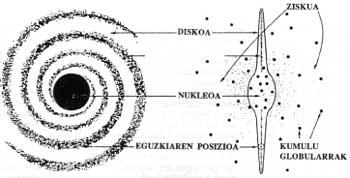French way galaxies
1990/12/01 Arregi Bengoa, Jesus Iturria: Elhuyar aldizkaria
All the lights that we can see at first sight in a starry night, except a few, come from objects scattered in a relatively small region around our Solar System. Most are stars, but there are also clouds of gas and dust, which we call galactic nebulae. The latter have no light of their own.
We can see them by the influence of the radiation of the stars they have inside or in their surroundings or because they reflect their light. Naturally, there are large amounts of gases and dust that remain invisible throughout the dark space. This interstellar matter is the one that prevents us from seeing better the broad system in which we are immersed. Stars, gas and interstellar dust are the components of the groups we call galaxies. What concerns us is called the French Way or the Milky Way, and we also have galaxies the few objects mentioned at the beginning that do not belong to this galaxy.
Smaller galaxies are about 6,000 light years in diameter. Among the largest have also been seen 170,000 light years. The limits of the number of stars range from 3,000 million to 1,000 billion (1012). Interstellar dark matter can account for 10% of the total mass.

As for the French Way, it is shaped like a launa disk, but has a core more belly in the center. The entire disc is surrounded by a sphere of equal radius. This sphere consists of stars and ancient star clusters, called halos or castles. As can be seen in the image, within the disc spiral arms develop much thinner than it. In short, these are concentrations of clouds of gas and dust.
The maximum diameter of the disc is 100,000 light years and a thickness of 2,000, but as mentioned above, the core is wider and reaches 15,000 light-years. The Sun is in a rather eccentric position, about 32,000 light-years from the centre, in the arm of Orion. From the studies of cool hydrogen clouds from Earth, more than forty years ago an approximation was made to the spiral structure of the region around the Sun.
Fragments of three arms could be found: that of Orion in which we are, that of Sagittarius (6,000 light-years towards the center of the galaxy) and that of Perseus (800 light-years outward). Today we know that there is another arm (the closest to the center) in the Centauro. However, it must be said that because they are inside galaxies, some of their wide regions cannot be studied. Consequently, it is not possible to realize a structural plane of its totality.
GroupLocalSystem nameLuminous diameter
SculptorWolf-LundmarkIC
1613NGC 6822NGC
221 (M32)NGC
205NGC
224
(M14G53G531)
Estimates of the number of stars the French Way could have yielded different results, but all of them are hundreds of billions scarce. The calculation of the mass is not simple either, but 2.5. It could be around 1041 kg, that is, 150,000 million times the Sun. About half of this mass would be concentrated in the core and the other half would be arranged in the disc and cistern.
Therefore, in no case can we affirm that the distribution of matter is homogeneous. The increase in density is evident as we approach the center. Thus, the closest star to the Sun is Alpha Centauri (4.3 light-years), followed by Barnard Estrella (6 light-years) and the next is Wolf 359 (7.7). At the core, however, the distance between the stars is not estimated greater than that of a few weeks of light.
In the table we have a list of galaxies around the French Way. These galaxies form the group called Local Group. Finally, however, we will say that the number of galaxies discovered to date is approaching 200,000.
EPHEMERIS SUN: On
PLANETS:
|

Gai honi buruzko eduki gehiago
Elhuyarrek garatutako teknologia



